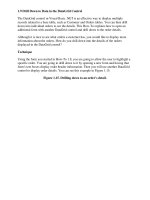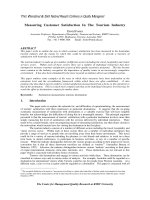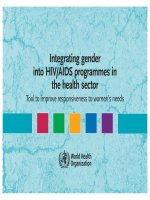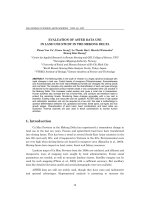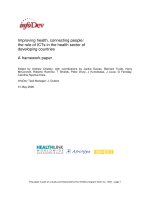Meaning in Suffering Caring Practices in the Health Professions pptx
Bạn đang xem bản rút gọn của tài liệu. Xem và tải ngay bản đầy đủ của tài liệu tại đây (1.65 MB, 305 trang )
Meaning in Suffering
Interpretive Studies in Healthcare and the Human Sciences
Volume VI
Series Editors
Nancy L. Diekelmann, PhD, RN, FAAN, Helen Denne Schulte Professor
Emerita, School of Nursing, University of Wisconsin–Madison
Pamela M. Ironside, PhD, RN, FAAN, Associate Professor, Indiana University
School of Nursing
Editorial Board
David Allen, PhD, RN, FAAN, Professor, Department of Psychosocial
Community Health, University of Washington School of Nursing
Michael E. Andrew, PhD, C.Stat., Mathematical Statistician, Centers for
Disease Control and Prevention, National Institute for Occupational
Safety and Health
Patricia Benner, PhD, RN, FAAN, Professor, Department of Physiological
Nursing, University of California–San Francisco School of Nursing
Karin Dahlberg, PhD, RN, Professor, Department of Health Sciences, Borås
University, Borås, Sweden; Professor, Department of Caring Sciences,
Mälardalens University, Eskiltuna, Sweden
Daniel W. Jones, MD, Associate Vice Chancellor, Herbert Langford Professor
of Medicine, University of Mississippi Medical Center
Kathryn H. Kavanagh, PhD, RN, Professor, Department of Sociology,
Anthropology, and Criminal Justice, Towson University
Fred Kersten, PhD, Frankenthal Professor Emeritus of Philosophy, University
of Wisconsin–Green Bay
Birgit Negussie, PhD in International Education, Docent in Education,
Professor Emerita in Education at the Stockholm Institute of Education
Thomas Sheehan, PhD, Professor, Department of Religious Studies, Stanford
University; Professor Emeritus, Department of Philosophy, Loyola
University, Chicago
Meaning
in Suffering
Caring Practices
in the Health Professions
Nancy E. Johnston
and
Alwilda Scholler-Jaquish
Volume editors
THE UNIVERSITY OF WISCONSIN PRESS
The University of Wisconsin Press
1930 Monroe Street, 3rd Floor
Madison, Wisconsin 53711-2059
www.wisc.edu/wisconsinpress/
3 Henrietta Street
London WC2E 8LU, England
Copyright © 2007
The Board of Regents of the University of Wisconsin System
All rights reserved
13542
Printed in the United States of America
Library of Congress Cataloging-in-Publication Data
Meaning in suffering : caring practices
in the health professions / edited by
Nancy E. Johnston and Alwilda Scholler-Jaquish.
p. cm.—(Interpretive studies in healthcare and
the human sciences; v. 6)
Includes bibliographical references and index.
ISBN 0-299-22250-0 (cloth: alk. paper)
ISBN 0-299-22254-3 (pbk.: alk. paper)
1. Suffering 2. Medical care 3. Terminal care
I. Johnston, Nancy E. II. Scholler-Jaquish, Alwilda. III. Series.
[DNLM: 1. Pain—nursing. 2. Stress, Psychological—nursing.
3. Empathy. 4. Palliative Care—methods.
5. Terminal Care—methods. WY 160.5 M483 2007]
BF789.S8M43 2007
616´.029—dc22 2006031772
Dedicated to our fathers
james robert porter
(1919–2006)
and
donald lee scholler
(1913–2005)
who taught us how to find
meaning in suffering
Contents
Acknowledgments ix
Introduction 3
n ancy e. johnston and
alwilda scholler-jaquish
1 Meaning in Suffering: A Patchwork Remembering 7
kathryn h. kavanagh
2 The Gift of Suffering 60
ingrid harris
3 Finding Meaning in Adversity 98
n ancy e. johnston
4 Narrative Phenomenology: Exploring Stories
of Grief and Dying 144
craig m. klugman
5Wish Fulfillment for Children with Life-Threatening
Illnesses 186
bonnie ewing
6 Moral Meanings of Caring for the Dying 232
shelley raffin bouchal
Contributors 277
Index 279
vii
Acknowledgments
No volume comes to fruition without the contributions of many people.
Although we cannot name all of the generous people who offered their
time, wisdom, and talent, we would like to particularly acknowledge the
following people:
Nancy Diekelemann and Pamela Ironside for their wise guidance
and encouragement.
Kathryn H. Kavanagh for her contribution to this volume, astute
counsel, and unfailing friendship.
Nadine Cross for her skillful accompaniment through challenging
times.
Christine Sorrell Dinkins for her ability to make excellent ideas
sparkle.
The authors for the knowledge and skill that went into producing
outstanding manuscripts.
The reviewers who responded generously to our call and offered
their insightful comments under tight time constraints.
Our families who assumed extra burdens and gave us gifts of time
so that we could work on this volume.
And each other for the journey we have shared. It has taken us to
places we never imagined, deepening our mutual trust, respect,
and friendship.
ix
Meaning in Suffering
Introduction
n ancy e. johnston and
alwilda scholler-jaquish
Suffering does not happen to us; we happen to suffer. Suffering is what we
choose to do with pain.
Younger, 1995, 55
When we suffer personally, and when we encounter the suffering of
another person, we are confronted with many questions. A taken-for-
granted and apparently robust future now jeopardized leaves in its place
a hollow of uncertainty and fragility. Painfully unsettling, suffering seems
to call forth a natural human proclivity to distance oneself from the spec-
ter of vulnerability. Understandably there is a tendency for healthcare
professionals to protect ourselves from the ravages of suffering encoun-
tered in the lives of the persons we care for. We do this by relating from a
distance even though this is incongruent with our commitment to remain
engaged and to care compassionately. This volume calls us to strengthen
our capacity to remain fully present to individuals and their families dur-
ing times of profound loss and also reveals ways in which new possibilities
both arrive and are closed down during suffering.
In the opening chapter Kathryn H. Kavanagh uses narrative ethnog-
raphy to offer an intimate portrait of one woman’s journey with a chronic
illness. She deepens our understanding of the essential facts of suffering,
illuminates how meaning and purpose come to be challenged in a time of
suffering, and reveals how the self comes to be redefined. Laying the
foundation for her interpretive inquiry by developing the metaphor of
quilt, Kavanagh asks how we explore and understand such interrupted
3
4 introduction
lives. She explores this question by writing that we understand by listen-
ing, and further suggests that listening involves “attending to both the
dominant and the muted meanings . . . [and] searching for the pain and
stories that lie outside expectable discussion.”
Ingrid Harris then offers a compelling philosophical approach to suf-
fering. Suggesting that suffering can be a gift, Harris creates awareness
of the opportunities that come to sufferer and healer alike. Drawing on
the thought of Calvin Schrag, she writes that the way the gift becomes
present is through the interaction of the sufferer and the healer. Harris
reminds us that meaning is double edged since it is all too often that neg-
ative rather than positive meanings are taken up. These negative, de-
structive meanings close down our ways of being in the world, prevent
healing, and distort attempts to regain wholeness. Expanding further on
how health professionals can respond “fittingly” in ways that help with
the reconstruction of positive meanings, Harris encourages us to con-
sider the infinite number of possible ways our imagination allows us to
interpret any event.
Nancy Johnston takes the position that enabling healthcare profes-
sionals to come to grips with suffering in a way that helps them to over-
come the tendency to care “at a distance” requires a new discourse. This
discourse must not only enable us to understand the threats to meaning
and purpose that people experience during a time of adversity but it must
also generate knowledge about how meaning comes to be restored in
the face of great trial and hardship. She also shows how her interpretive
phenomenological study contributes such knowledge by illuminating
how people reconstruct meaning in situations of adversity and by shed-
ding light on human and healthcare practices that both help and hinder
the restoration of positive meanings.
Craig Klugman uses a narrative phenomenological study to reveal
how the practice of inviting bereaved people to tell stories of loved ones
who are deceased assists individuals to accomplish important grief work.
Noting that tellers are often searching for new hope, new interpreta-
tions, and new outcomes, Klugman affirms that it is during a “break-
down” that people have the opportunity to grasp new meaning about
their lives. Revealing the power of storytelling as a caring health practice,
Klugman shows how it enables catharsis, heals wounds, constructs new
meanings, restores connections to community, and fosters openness to
new experiences.
Bonnie Ewing explores the meaning to dying children of a well-
intended social practice—the granting of special wishes to children with
a life-threatening illness by the Make-A-Wish Foundation. Addressing
the special challenges of gaining access to children’s perspectives uncon-
taminated by adult preconceptions and expectations, Ewing describes a
hermeneutical phenomenological study in which children were invited to
express their experiences through artwork. Explicating the embedded
meanings that were manifested in symbols and images in the children’s
drawings, she uncovers the shared meanings of children with life-
threatening illnesses who have had their special wish fulfilled. In this way
she brings to expression experiences that could not otherwise be articu-
lated. Reflecting on the implications of the study, Ewing suggests that
conventional treatments intended to perpetuate life should be evaluated
carefully against the benefits that can be secured by focusing more inten-
tionally upon the preservation of quality of life for dying children
In the final chapter Shelley Raffin Bouchal offers an ethnography of
the human practices of nurses who care for dying individuals. Illuminat-
ing the sense of vocation that nurses often bring to their work, she de-
scribes the “calling” they experience in helping their patients to live fully
while dying. Raffin Bouchal connects us to the realities of pain, loss, and
suffering that are inevitably part of the journey by describing the chal-
lenges encountered by nurses as they experience intense interpersonal
involvement within the context of their patients’ limited time horizons.
By depicting the human connections, transformations, and social realities
that arise on a palliative care unit, Raffin Bouchal reveals how nurses en-
dure suffering, confront death, and reflect on the meaning of life.
This volume, the sixth in the series Interpretive Studies in Health-
care and the Human Sciences, presents many voices of suffering and chal-
lenges healthcare professionals to respond fittingly to the call to care. As
we offer new ways of thinking about suffering, we invite everyone to re-
main open to the possibilities that arrive with suffering and to become at-
tentive and skillful cocreators of meaning.
References
Cassell, E. J. (1991a). The nature of suffering and the goals of medicine. New York: Oxford
University Press.
Cassell, E. J. (1991b, May–June). Recognizing suffering. Hastings Center Report, 24–31.
Diekelmann, J. (2005). The retrieval of method: The method of retrieval. In P. M. Ironside
Introduction 5
6 introduction
(Ed.), Beyond method: Philosophical conversations in healthcare research and schol-
arship (pp. 3–57). Madison: University of Wisconsin Press.
Diekelmann, N. (1991). The emancipatory power of the narrative. In Curriculum revolu-
tion: Community building and activism (pp. 41–62). New York: National League for
Nursing.
Frank, A. W. (2004). Dignity, dialogue, and care. Journal of Palliative Care, 20, 207–211.
Frankl, V. E. (1984). Man’s search for meaning. New York: Washington Square Press.
(Original work published 1946)
Fredriksson, L., & Eriksson, K. (2001). The patient’s narrative of suffering—a path to
health: An interpretive research synthesis on narrative understanding. Scandinavian
Journal of Caring Science, 15, 3–11.
Gadamer, H G. (2003). Truth and method (2nd ed.; J. Weinsheimer & D. G. Marshall,
Trans.). New York: Continuum. (Original work published 1960)
Heidegger, M. (1977). The question concerning technology. In The question concerning
technology, and other essays (W. Lovitt, Trans., pp. 3–35). New York: Harper & Row.
Heidegger, M. (1993b). The origin of the work of art. In D. F. Krell (Ed.), Basic writings
(A. Hofstadter, Trans., pp. 143–203). San Francisco: HarperSanFrancisco. (Original
work published 1960)
Madison, G. B. (1990). The philosophical centrality of the imagination: A postmodern ap-
proach. In G. B. Madison, The hermeneutics of postmodernity: Figures and themes
(pp. 178–195). Bloomington: Indiana University Press.
Madison, G. B. (2005). On suffering. Unpublished manuscript.
Polkinghorne, D. (1988). Narrative knowing and the human sciences. Albany: State Uni-
versity of New York Press.
Picard, C. (1991). Caring and the story: The compelling nature of what must be told and
understood in the human dimension of suffering. In D. A. Gaut & M. M. Leininger
(Eds.), Caring: The compassionate healer (pp. 89–98). New York: National League
for Nursing.
Rogers, B. L., & Cowles, K. V. (1997). A conceptual foundation of human suffering in
nursing care and research. Journal of Advanced Nursing, 25, 1048–1053.
Sahler, O. J. Z., Frager, G., Levetown, M., Cohn, F. G., & Lipson, M. A. (2000). Medical
education about end-of-life care in the pediatric setting: Principles, challenges, and
opportunities. Pediatrics, 105, 575–584.
Schrag, C. O. (2002). God as otherwise than being: Toward a semantics of the gift. Evans-
ton, IL: Northwestern University Press.
Schrag, C. O. (2004). Ethics of the gift: Acknowledgement and response. Symposium, 8,
195–212.
Schafer, R. (2004). Narrating, attending, and empathizing. Literature and Medicine, 23,
241–251.
Steeves, R. H., & Kahn, D. L. (1987). Finding meaning in suffering. Image: Journal of
Nursing Scholarship, 19, 114–116.
Wuthnow, R. (1991). Acts of compassion: Caring for others and helping ourselves. Prince-
ton, NJ: Princeton University Press.
Younger, J. B. (1995). The alienation of the sufferer. Advances in Nursing Science, 17(4),
53–72.
1
Meaning in Suffering
A Patchwork Remembering
kathryn h. kavanagh
Dr. Rain appeared, the bulging pockets on her white jacket straining
its center button. She absentmindedly squelched buzzing apparatuses
while looking around the room at the four of us and ascertaining our rela-
tionships with her patient. She then addressed herself to Joanne: “Well,
the chances are about 10% of surviving a year without treatment.” She
paused. “And about 10% with treatment.” She filled the room with jargon
and checked to see if we followed; we did, except for Walt, Joanne’s hus-
band of 41 years—but he did not interrupt, and we three nurses did not
slow down the talk on his behalf. Dr. Rain asked what questions we had.
She was careful not to seem pushy about the experimental drug. It was all
palliative now.
Joanne had had polymyositis for 20 years, but it was leukemia sound-
ing the death knell. Both the stroke a few weeks earlier and the newly
diagnosed leukemia were attributed by the clinicians to past treatments,
and here they were pushing another drug. I learned later that Joanne had
figured it out. She had written in her diary two years earlier: “I’m con-
vinced it’s due to 17 years chemo meds for poly and now the side effects
are showing their ugly face” [Diary 2].
1
Dr. Rain covered everything she could imagine being of use and got
from us every question we could produce. Joanne’s decision to partici-
pate in the drug trial was not a difficult one when there wasn’t going to be
much time no matter what she did. The talk was of possibilities, not prob-
abilities; the prize was quality of life, not quantity. More “older people”
were needed to participate; participation was a contribution. Dr. Rain
7
8 kathryn h. kavanagh
chuckled when we bristled at the “older people” language and acknowl-
edged that we four sixtyish folks were on the young side of old.
Joanne communicated a need to commit herself to action, which was
typical Joanne. Walt interjected something about Joanne’s ashes going to
a reef in the ocean if and when it came to that. It seemed both a surpris-
ing note and an indication that he too was processing all this at deeper
levels. Joanne would go along with the new drug—“What else can I do?”
Only later did I realize that she had broken the poststroke pattern of
stopping after the second word. As soon as it was known that the drug
trial would have another participant, the project director arrived with a
flurry of forms for which she efficiently extracted shaky signatures. Then,
as she attempted a hasty exit, Joanne stopped her. Dr. Rain had returned
with more printouts. I was awed when Joanne, with no reference to
her own plight but ensuring the attention of the supervising physician,
stammered out a compliment about young Dr. Rain’s caring presence.
Quilt—A Bedcover Made by Stitching through the Whole:
Coming to the Inquiry
All interpretation is grounded in understanding.
Heidegger, 1927/1962a, p. 195
Joanne was a quilter, and quilts are storied. Quilting, like hermeneu-
tics, invites ongoing dialogue and makes possible the making, preserving,
and sharing of meaning. Symbolism and openness abound in the gather-
ing of hundreds of individual pieces in their path toward being “singular
plural” (Nancy, 2000). Joanne’s quilting lends a metaphor for her story
through its creative organization, its enduring commitment, its colorful
sense of play, and, in more philosophical terms, the situatedness of every-
day activities with their embedded knowing, which involves the person-
world that both shapes us and is shaped by us (Heidegger, 1927/1962a).
Challenges were nothing new to Joanne. I had been aware of her
physical limitations for at least a decade. I even brought them up, only to
have Joanne sidestep that conversation with “Oh, it’s just a muscular
thing” and a joke about aging. The boundary “draws us by its very with-
drawing” (Diekelmann, 2005, p. 3). While a student in a nursing master’s
program, Joanne took my healthcare and culture courses and involved
herself in diversity workshops I led. We also shared an interest in sewing
and quilting; I teased her about being the only person I knew who owned
two Berninas. The Bernina is a Swiss-made sewing machine, and I have
owned two in the past 40 years (the first one still works); Berninas are
made for serious sewers. Joanne and I occasionally went to quilt shows,
but more often we met to discuss culture and nursing, particularly when
she encountered people with backgrounds unfamiliar to her. Over the
years I watched Joanne go from being ambulatory, albeit unable to “do
steps,” to needing arms on chairs to push herself up, and finally to an
electric cart to get around. One night, outside a diner with a good ramp
and wheelchair seating, she demonstrated with pride the lift in her van.
Her friend Millie helped her figure out how to pull down the van door
after getting the cart inside. I admired Joanne’s independence, but I still
knew nothing about polymyositis.
After Joanne’s son Chris called to tell me she’d had a stroke I visited
her whenever I could, following her from her local hospital to a rehabili-
tation center and then to the cancer unit of a major medical center when
leukemia was diagnosed. Watching this highly verbal woman struggle for
words, I saw suffering in her living with a chronic debilitating disease now
compounded by a stroke and then superimposed with acutely devastating
leukemia.
2
What is more, Joanne was not the only one suffering; there was
Walt too. Joanne said she would think about writing her story with me. A
few weeks later, hospitalized yet again, she said, “Okay, do it.” Language
serves to substitute no-thing for a thing no longer there (Mairs, 1996),
while in the coalescence of thrownness, understanding, and language lies
the possibility of being fully human (Diekelmann, 2005, citing Heideg-
ger). Joanne’s words came in fragments, patched together like a few more
pieces of a quilt. Aware of the impact of the stroke on her linguistic com-
pensations for her physical problems, I thought aphasia had left the “let’s”
out when she said “do it.” Now I am not so sure. How do we explore and
understand such interrupted lives? Listening involved attending to both
the dominant and the muted meanings. Heilbrun (1988) urges searching
for the pain and stories that lie outside expectable discussion. Personal
oral narratives in conversational contexts can be emancipating (Borland,
1991; Diekelmann, 1991), as were, according to her daughter-in-law Kris-
ten, the stories that Joanne so loved hearing about her grandchildren.
The oldest of the arts (Cruikshank, 1992), storytelling is at the core of
the search for meaning. Stories are never simple and always have multiple
Meaning in Suffering 9
10 kathryn h. kavanagh
perspectives. Nor do they involve only individuals. For example, Joanne
was to be in the hospital only four days for the experimental treatment.
The first dose of the drug was inserted into Joanne’s intravenous line. The
combination of the extra fluids and who knows what else—the clear liq-
uid looked so innocent up there in its little plastic bag—set Joanne’s heart
racing and her chest heaving. Walt ran for a nurse: “She’s in trouble!” It
was a small blip in medical history, but it was terrifying. Joanne thought
her chest was going to explode, and Walt thought she was going to die.
Later, when Walt spoke of going home exhausted after Joanne’s first
treatment, I asked whether he had finally got some rest and whether he
had called their sons Skip and Chris—both adults, married, and fathers.
The answer to both questions was no. Instead, he said, he “cried half the
night.” This was suffering cosuffered.
When Joanne agreed to our study, I, a medical anthropologist, started
keeping field notes. Inquiry requires thick description, careful listening,
and reading between the lines. Notes of my visits, for instance, went like
this:
The medical center wanted Joanne treated like an out-patient and Joanne
wanted to go home. I was to visit her today, but I got a message from Walt that
her schedule had again been changed. Last week they ended up at the cancer
unit four days, sometimes for hours at end, and sometimes with nothing getting
done to or for Joanne when they were there. There seems to be little considera-
tion of the effort involved in Walt’s getting Joanne up and fed, bathed, clothed,
and out to the van for the forty-minute trips into the city. Where would Joanne be
without Walt? He says she is tired, she gets tired of sitting and waiting: “Every-
thing hurts.” Who gives the health system the authority to put a person on hold
like that?
Their lives revolved around good days, bad days, but few predictable
days—or even hours. Joanne and Walt lived in response to her physical
condition, no longer merely around it. That meant Joanne could not at-
tend the speech therapy and physical therapy sessions that symbolized
for her the climb back to normalcy after the stroke. Joanne had little re-
sidual paralysis, but she was frustrated with her speech and cognitive im-
pairment. Walt took her to work with a woman who had worked with
other quilters who had had strokes—Joanne was excited. Her daughter-
in-law Kathleen described it: “She was getting her energy back. It was as
if she said, ‘Okay, now I’ve had my cry and I’m moving on.’” But she had
the chance to visit the sewing coach only once. Her condition and the
“new drug” overwhelmed any quality of life.
Finding the Materials, Revealing the Pattern: The Inquiry
As if unfolding toward an ethos of the unknown, flexibility charac-
terizes the crazy quilts of lives today. The paths of our existence are no
longer limited by old rhythms of production and procreation but are
instead indeterminate and full of myriad commitments and new begin-
nings. Continuity is the exception; adapting to discontinuity is an emerg-
ing problem of the era (Bateson, 1990). Composing a life involves contin-
ual reimagining of the future and reinterpretation of the past. While our
lives are generally longer and more filled with possibilities than ever
before, we are also more likely to engage in a day-to-day process of self-
invention than in one of discovery. Then along comes a catastrophic diag-
nosis and prognosis. I wanted to know how one bears pain and uncer-
tainty or the immediate reality of nausea and vomiting so violent that it
seems it will not stop. Where is the meaning in such compromised exis-
tence? Hampl (1999) says pain has strong arms. As individuals and as a
couple, Joanne and Walt were clearly in its grip.
How easy it is to wish for a trajectory of healing and improving health;
how powerless one feels knowing that whatever will happen will happen.
For most of us living everyday lives, the notion of being at the mercy of
what our bodies can or cannot do is merely a mental exercise. As parts of
a modern society we spend little time contemplating bodily functioning,
let alone mortality. How often do we think about what tattered remnants
of life constitute humanity when the whole is damaged? These questions
are harder to know, perhaps, when our culture splatters mortality across
the media with such indifference as to render it meaningless. Isak Dine-
sen wrote: “All suffering is bearable if it is seen as part of a story” (cited in
Metzger, 1992, p. 47). I wrote in my notes: “What is the story here? Will
it all be over before it begins?”
When Joanne agreed to work with me on her story, I told her we
would make it her memoir, since that genre depicts the author’s life viv-
idly, affectively, and uniquely (Tedlock, 2000). Memoir creates a window
into a life, acknowledging the importance of a historical perspective and
Meaning in Suffering 11
12 kathryn h. kavanagh
highlighting a point of view (Frank, 2000). I pondered the task of cowrit-
ing a memoir with someone severely compromised in communication.
Can a woman who can get out only every third word “write” a memoir?
Not that Joanne ever particularly liked writing. Now she was very ill and
could barely sign her name, and construction of the quilt squares she was
working on when she had the stroke eluded her. But the stroke was only a
new wrinkle in the old problem. Years earlier Joanne wrote: “Also went to
speech evaluation. Didn’t do well—there is a lot of facial and throat and
tongue involvement” [Diary 1]. Now the brain conspired with the mus-
cles against speech. During her hospitalizations she learned the risks and
frustrations of the staff ’s not knowing what she meant or wanted. Joanne
clung tightly to Walt’s presence; his interpretation of her speech and
needs proved more valid and reliable than anyone else’s. Did her discom-
fort distract her from concern about the future or exacerbate it? Cure was
beyond our purview; how might we help her heal? Could I hear these
things if Joanne communicated them to me? Joanne’s memoir evolved
into narrative ethnography, which combines life history and memoir.
Final Stitches
In the midst of life we are in death.
Book of Common Prayer, 1928, p. 332
The dwindling sands in Joanne’s hourglass evoked for me the hungry
ghosts of Buddhist iconography. Portrayed as beings with huge bellies
that serve as storehouses for all they can possibly consume, their throats
are as narrow as needles. Whatever they put in their mouths leaves them
unsatisfied, so they perpetually devour anything they can (Levitt, 2003). I
likened the task of representing Joanne in her story to the ritual feeding
of the hungry ghosts; I wanted to understand everything I could of her
experience. Despite their dissatisfied natures, hungry ghosts are fed the
food of awakening directly from the Buddha’s bowl, making new realiza-
tions possible. The narrow place, having an opportunity to be expressed,
becomes a path of freedom. I wanted Joanne to share with me her stories
about suffering. Joanne’s work and her play were purposeful, and she
kept at them, staving off suffering’s victory when it would make accom-
plishment impossible (Cassell, 1991b). How was that? The storyteller
picks the material and knows where she is and where she intends to go. It
would be her voice, her characters, her worldview (See, 2002) while I
wrote—but that was not to be. Yet suffering and transcendence are
among the things most at stake in daily experience; they deserve to be the
focus of study (Kleinman, 1995).
Walt called. “Joanne was pronounced at 8:15 this morning.” After a
harrowing month Joanne’s friend Ski wrote in the notebook the family
kept at Joanne’s bedside: “She had Walt, Skip, and Chris at her side. It
was [a] peaceful and beautiful death—just as she would have wanted it.”
Later a friend said, “She got tired. She just got too tired and could not do
any more.”
Notes from the funeral:
The church is a work in progress, the ceiling a patchwork of squares in transition
or missing. Joanne would have appreciated that. She is there, her cremains under
one of her most colorful quilts. A couple hundred people gathered to celebrate
her existence and to grieve her departure. They look a homogeneous lot; Joanne
would have voted for more diversity in the congregation. There are beautiful
stories shared by those closest to Joanne. Stories about her more recent years—
storms of ill health and her insistent striving for that rainbow, her spirit of joy and
bursts of creativity, the flaming red hair proclaiming her philosophy of life, her
stubbornness and culinary disasters. But most of the stories were about her car-
ing, her being the consummate people person, her many years in nursing, and
her desire for a legacy. This went beyond not speaking ill of the dead; people re-
spected Joanne.
Ski, Joanne’s longtime friend, coworker, and cosurvivor of various
nursing education programs, told a story about Joanne tipping over an
equipment tray to prevent some eager doctor from doing something
completely misguided to his patient. Ski wound around her own neck a
fuchsia feather boa she’d bought for Joanne; we all knew she would have
loved its flagrant flamboyance. Joanne was known for her thoughtful
gifts, carefully selected and often self-crafted to reflect highly individual
interests and tastes. I thought about Joanne and Walt planning to buy
their grandsons tickets for The Lion King at the Hippodrome in the
spring, which Joanne would not see. There were stories of the polymyo-
sitis and of loving her through the hard times. One of her sons made ref-
erence to her love of human diversity and how she encouraged them to
go and meet people unlike themselves—to meet them where they were
and to “always remember to bring back a piece of fabric.”
Probability suggests that women are more likely than men to en-
dure the loss of that “tangible ‘we’” of a life partner (Mairs, 1994, p. 134).
Meaning in Suffering 13
14 kathryn h. kavanagh
Because his own father and several uncles died young, Walt “set Joanne
up,” paying off the mortgage and anticipating that she would outlive him
by years. Instead, Joanne was 62 when she died. Falling off the actuarial
charts invites both wry outrage and a loneliness felt by one whose life un-
folds out of sync (Mairs, 1993). Joanne worked part-time until the stroke,
but her coworkers knew nothing of the polymyositis. How was it that
Joanne chose to live 20 years of suffering as she did? That others close to
Joanne knew so little about her health status was one of those absences
that begs retrieval (Diekelmann, 2005). Walt gave me two diaries that
Joanne began in 1985 when a physician suggested she journal her in-
creasingly unsettling health experiences. The earlier small book is in-
scribed: “Given to me by Charlotte from a yard sale for $.25,” and the
later one: “Diary of a/my disease.” Joanne used them primarily as medi-
cal journals. She typically added entries when she experienced health
problems; when in remission, she seldom wrote in them. I transcribed
both handwritten diaries, translating the medical jargon for Walt.
I then interviewed Joanne’s closest friends and her family: her
husband, sons, daughters-in-law, and grandsons. I initiated an ongoing
conversation with Karen, Joanne’s friend, who is a psychologist. Each of
these individuals spent an average of three or more hours with me in per-
sonal or phone interviews or, in the therapist’s case, ongoing e-mails.
3
I
encouraged each participant to use his or her own words and format.
Each understood the nature of the inquiry and my intent to write and
submit this manuscript, and each was invited to communicate additional
stories—most did. All of the interviews were transcribed with wide mar-
gins for notes. Strong patterns quickly emerged.
Through Joanne’s story I sought to examine the phenomenological
nature of sickness with the goal of deepening our grasp of human suffer-
ing. “[T]he quotidian truths of a body in trouble” (Mairs, 1996, p. 10) are
not generalizable but rather interpretations of particular participants
in particular situations. Stories are like babies: holding someone else’s
baby does not make it yours, but holding it does instill responsibility—in
this case, for understanding and representing (Kavanagh, 2005). Written
texts are never without ambiguity (Cruikshank, 1992), so it was a leap of
faith on the part of those people closest to Joanne to share their stories
with me. Additionally, given my own relationship with Joanne, I was chal-
lenged to attend to others’ perspectives and not confuse them with my
own. No one’s self-reflection is only a private, subjective act; it too comes


